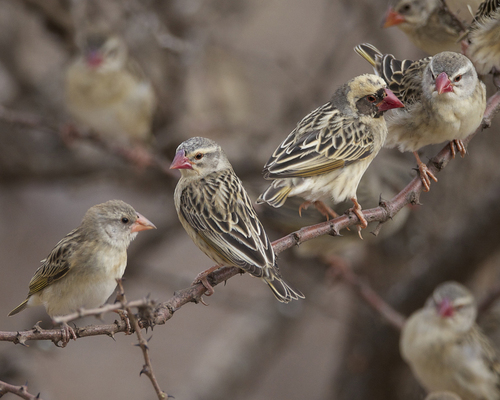
Red-billed Quelea
The Red-billed Quelea, with its vibrant red bill, weaves intricate nests in vast colonies across Africa's savannas. Known for its immense flocks, this seed-eating marvel plays a crucial role in the ecosystem, yet its sheer numbers can impact local agriculture.
2 years
Lifespan
28.3495 g
Weight
Length: 25 - 30 cm; Height: 5 cm
Size
Brown, Red, Purple
Color
1 year
Age of Sexual Maturity
10 days
Age of Weaning
25 mph
Top Speed
Least Concern
Conservation Status
Stable
Population Trend
Characteristics
The Red-billed Quelea, native to sub-Saharan Africa, is a small, gregarious bird known for its massive flocks. It thrives in savannas and grasslands, feeding primarily on seeds. Notable for its striking red bill, it exhibits complex social behaviors and is considered one of the most numerous bird species globally.
Distribution Range of the Red-billed Quelea
The Red-billed Quelea (Quelea quelea) is native to sub-Saharan Africa. It is widely distributed across this region, inhabiting countries from Senegal and Mauritania in the west to Ethiopia and Somalia in the east, extending southwards to South Africa and Namibia.
Red-billed Quelea's Habitat
Environmental Conditions
The Red-billed Quelea typically inhabits open savannas, grasslands, and agricultural fields. It thrives in regions with a semi-arid to arid climate, characterized by seasonal rainfall patterns. The species is well-adapted to areas with sparse tree cover and prefers habitats where grasses and grains are abundant.
Ecological Niche
Quelea quelea is known for its granivorous diet, primarily feeding on seeds of grasses and grains. This species plays a significant role in controlling vegetation growth, although it can also become a pest to crops such as millet and sorghum. Its ability to form large flocks allows it to exploit food resources efficiently, and it often adapts to changes in agricultural practices and environmental conditions.
Copyright @ Nature Style Limited. All Rights Reserved.
 English
English